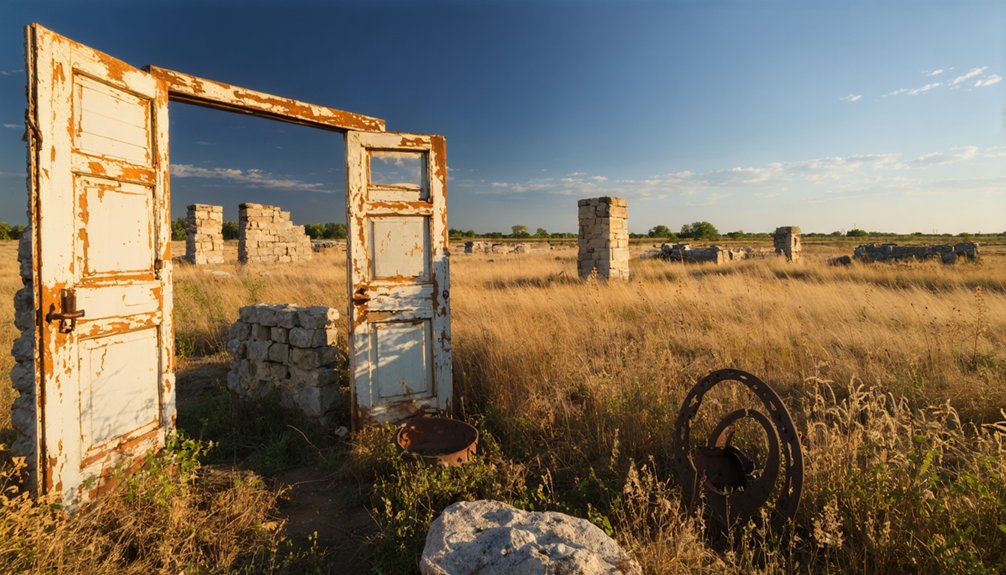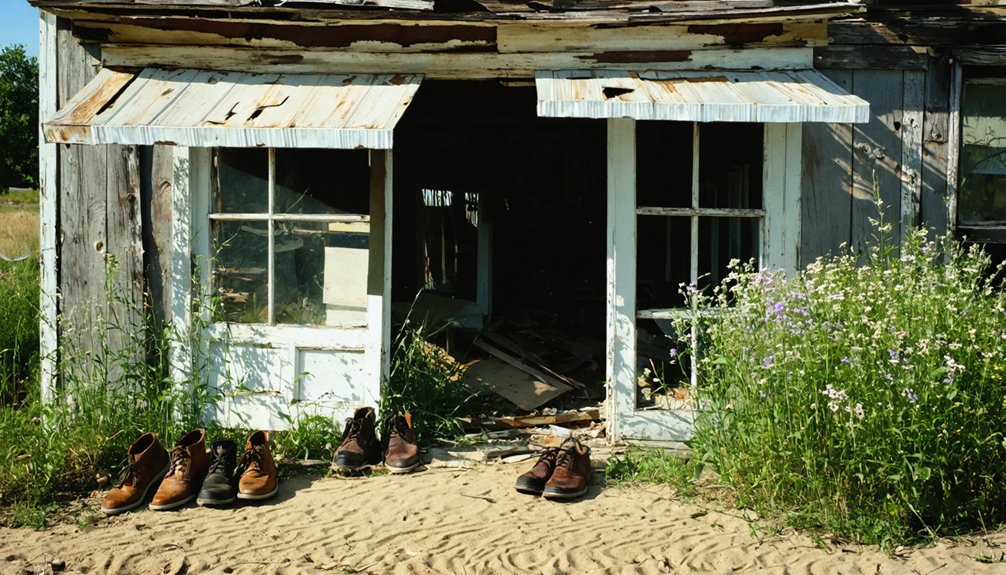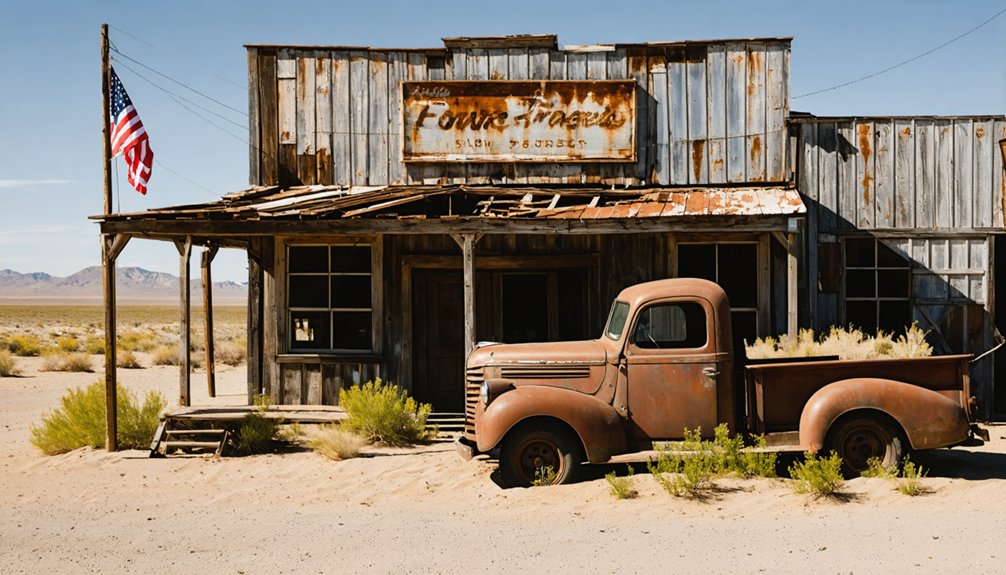You’ll find League Four in Crosby County, Texas, a ghost town established in the late 19th century and named for its 4,428-acre land measurement unit. This rural settlement focused on ranching and farming, featuring a single-room schoolhouse and church gatherings. The town’s decline began when railroads bypassed it, while drought and economic hardships forced residents to leave. Archaeological excavations have uncovered thousands of artifacts, and local legends of ghostly cowboys and La Llorona still echo across its abandoned plains.
Key Takeaways
- League Four was a late 19th-century settlement in Crosby County, Texas, named after its 4,428-acre land measurement unit.
- The community relied on ranching and farming but declined after being bypassed by railroads and facing agricultural challenges.
- Archaeological findings include European artifacts, military items, and coins, indicating cultural interactions between settlers and indigenous populations.
- The town’s infrastructure consisted of basic necessities, including a single-room schoolhouse that served both educational and religious purposes.
- League Four’s decline was accelerated by economic factors, including failed mining operations and a 40% drop in property values.
The Rise and Fall of League Four
While many Texas ghost towns boomed from oil or mining, League Four emerged as a modest settlement in Crosby County during the late 19th to early 20th century frontier expansion.
Named for the land measurement unit of a league (4,428 acres), the town’s settlement patterns reflected the era’s agricultural focus.
You’ll find that League Four’s community dynamics centered on ranching and local farming, with minimal infrastructure beyond basic necessities. Unlike Thurber which attracted nearly 10,000 immigrant workers, League Four maintained a small, mostly local population.
Like 511 other ghost towns across Texas, League Four never developed significant industrial activity or experienced dramatic population growth.
Instead, it followed a common trajectory of rural Texas settlements: initial establishment during westward expansion, followed by gradual decline as transportation routes bypassed the area.
Historical Records and Documentation
Although League Four appears in some historical publications about Crosby County, Texas, you’ll find that authoritative documentation about this settlement remains remarkably sparse.
The archival challenges in establishing historical accuracy about League Four are significant, with most mentions appearing only in broader regional ghost town studies. Like the former town of Texana, which vanished despite its historical significance, League Four’s records have largely disappeared from public archives. Similar to thousands of other ghost town locations throughout Texas, detailed information about League Four has been lost to time.
You’ll discover these key documentation gaps:
- No detailed census records specifically track League Four’s population changes
- Economic and infrastructure records are virtually non-existent
- Land ownership documentation isn’t readily available in public archives
- Major state historical compilations like the Texas Almanac don’t officially classify it as a ghost town
While you can piece together some history through scattered references, League Four’s story largely remains shrouded in the same mystery that surrounds many small Texas settlements that faded into obscurity.
Geographic Location and Landscape
Three distinct geographic features define League Four’s location in Crosby County, Texas: the expansive Great Plains setting, the semi-arid climate, and the characteristic rolling prairies.
You’ll find this ghost town surrounded by native grasslands and scattered mesquite, where the land use has historically centered on cattle ranching and dryland farming. The settlement’s isolation from major transportation routes and urban centers contributed to its eventual decline, while environmental challenges like frequent droughts and strong winds tested the resilience of early settlers. Similar to League Four, the town of Prairie Plains relied heavily on cotton farming for its economic survival. Like the abandoned town of Terlingua, the area drew desert enthusiasts who appreciated its rugged landscape.
Today, the natural prairie ecosystem has largely reclaimed the area, with seasonal waterways cutting through the gently undulating terrain. The region’s soil composition and limited rainfall created conditions better suited for extensive ranching than intensive farming operations.
Settlement Life and Community
The rhythms of daily life in League Four reflected the close-knit dynamics common to isolated Texas settlements of its era. Community resilience was evident in how residents banded together, sharing resources and labor to maintain their rural way of life. Similar to Terlingua’s peak mining days, the town fostered a natural divide between Mexican and Anglo residents.
Agricultural practices dominated their daily routines, with families working together during planting and harvest seasons. Early records show that one notable resident, Preston Winthrop Esq., helped establish the first successful farming cooperative in the area.
Your life in League Four would’ve revolved around these core aspects:
- Single-room schoolhouse education that adapted to farming schedules
- Church gatherings that served as both spiritual and social centers
- Communication through word of mouth and occasional postal service
- Transportation by horse and wagon on dirt roads connecting to nearby settlements
The settlement’s isolation fostered strong bonds between neighbors, with churches and schools serving as essential hubs for community activities.
Economic Factors Behind Abandonment
If you’d explore the economic collapse of League Four, you’ll find the critical blow came when railroad companies bypassed the settlement in favor of routes through competing towns with stronger commercial prospects.
The town’s isolation from main transportation corridors led to a rapid exodus of businesses and residents to better-connected communities. This transportation disconnect, coupled with the decline of local cotton farming and mining operations, effectively sealed League Four’s fate as businesses shuttered and workers sought opportunities elsewhere. Home values plummeted by over 40 percent within just a few years, mirroring the housing market decline seen in many Texas towns today. Similar to many rural Texas communities today that have seen 26 rural hospitals close since 2010, League Four’s lack of essential services accelerated its demise.
Railroad Bypass Effects
During East Texas’ critical period of development in the late 19th century, railroad route planning dramatically shaped the economic fate of countless communities, including League Four.
The railroad impact on these towns was profound and often devastating, leading to community displacement as trade and commerce shifted to rail-connected locations.
When you examine the harsh realities of railroad bypass effects, you’ll find four critical consequences:
- Loss of competitive market access for local goods and materials
- Rapid decline in population as workers migrated to rail-served towns
- Closure of established businesses unable to compete with rail-connected merchants
- Reduced investment in local infrastructure and development
Without rail connections, League Four couldn’t maintain its economic viability, joining many other bypassed communities that gradually faded into obscurity as Texas’ transportation networks evolved.
Local Industry Decline
Beyond rail access challenges, League Four’s economic deterioration stemmed from its heavy reliance on singular industries, mirroring the fate of many Texas ghost towns.
You’ll find this industrial decline followed patterns seen in places like Shafter, where silver mining operations couldn’t weather market volatility, and Prairie Plains, where cotton processing became unprofitable.
When League Four’s primary industries faltered, the town lacked the economic diversification needed for community resilience.
Without sufficient capital to modernize operations or adapt to technological changes, local businesses couldn’t compete with larger regional centers.
Like many single-industry towns, League Four’s workforce faced familiar struggles – poor working conditions, inadequate wages, and limited opportunities.
As younger residents sought better prospects in urban areas, the town’s population dwindled, creating a downward spiral of decreased investment and eventual abandonment.
Mapping League Four’s Footprint
You’ll find League Four’s historic footprint within the survey boundaries established in the 1830s during Texas’s colonization period, covering approximately 4,428 acres near present-day Grimes County.
The site’s coordinates can be traced through early land grant surveys that show its position relative to neighboring leagues, including the McGuffin and Zuber properties to the east.
Modern GPS mapping has preserved League Four’s original boundaries, which encompassed cotton fields, multiple gin locations, and a small commercial district that once served the farming community.
Historical Site Coordinates
While League Four’s precise coordinates remain elusive in public records, historical evidence places this ghost town within Crosby County, Texas. The geographic challenges of pinpointing its exact location stem from limited documentation in public databases and historical archives.
You’ll find the historical significance of League Four reflected in these key coordinate-related details:
- The site’s position corresponds to Texas’s traditional league land divisions, similar to other ghost town patterns.
- Nearby ghost towns like Wayside provide regional reference points for approximate positioning.
- Historical mapping suggests ties to old railway lines and ranch boundaries.
- The location likely aligns with historical land grants, though modern GPS data remains incomplete.
When searching for League Four’s exact position, you’ll need to reference local historical archives and specialized Texas ghost town GIS data.
Known Landmarks Nearby
League Four’s footprint sits within a rich tapestry of historical landmarks, both natural and man-made.
You’ll find the stone ruins of Freo Town’s jail and courthouse about 60 miles northwest, while Katarina’s weathered foundations and chimneys stand as evidence to early settler life. The region’s historical architecture includes abandoned railroad stations, old bridges, and preserved homesteads that draw ghost town tourism enthusiasts year-round.
Natural landmarks complement these structural remains, with the Frio River carving through nearby terrain and the distinct landscapes of Big Bend in the distance.
You’ll discover interpretive signs and monuments marking significant sites, while pump jacks dot the horizon, creating a stark contrast between industrial present and abandoned past. Local cemeteries and cultural markers help piece together the area’s rich historical narrative.
Archaeological Evidence and Remnants

Archaeological excavations have revealed thousands of artifacts from League Four’s past, including glass fragments, pottery sherds, nails, and fireplace remains that paint a detailed picture of settlement life.
Artifact analysis has uncovered evidence of significant cultural interactions between European settlers and indigenous populations.
You’ll find these key discoveries at the site:
- European-derived items from post-1650, including Spanish spurs and French-style hoes
- Military artifacts like gun parts and personal items such as glass beads in shallow deposits
- Early 19th century coins showing economic activity during the Texas Republic period
- Structural remnants of fireplaces and taverns indicating communal gathering spaces
The site’s location in a floodplain has helped preserve many artifacts, though only a small portion has been excavated, suggesting more discoveries await beneath the surface.
Local Legends and Stories
Throughout the decades following League Four’s abandonment, the ghost town has become steeped in supernatural folklore that blends Hispanic and Anglo-American cultural elements.
You’ll hear tales of haunting spirits like La Llorona weeping near the lake, where locals say a cursed wife’s ghost still roams after accidentally killing her husband. The area’s eerie atmosphere intensifies with stories of ghostly cowboys appearing near distinctive rock formations, accompanied by phantom hoofbeats and unexplained cold winds.
Near the lake, La Llorona’s haunting wails echo through the night, while ghostly cowboys ride past ancient stones in phantom winds.
Local folklore also includes witchcraft legends, particularly the tale of Lauza, who transforms into an owl-creature with hypnotic yellow eyes.
In the abandoned buildings, you might encounter miner ghosts, their spectral activities a reflection of the town’s boom-and-bust history. These supernatural transformations and cultural heritage stories preserve League Four’s historical context through generations.
Legacy in Texas History

While supernatural tales paint one picture of League Four’s memory, its true historical significance lies in what it reveals about Texas’s dynamic frontier development.
You’ll find its legacy embedded in the broader story of Texas settlement patterns and community dynamics that shaped the state’s identity.
Four key aspects define League Four’s historical importance:
- It represents one of Texas’s 511 ghost towns, showcasing the volatile nature of frontier settlements.
- The town’s agricultural practices, particularly cotton farming, mirror the economic activities that drove early Texas development.
- Its land grant origins provide insight into how Texas distributed territory during its formative years.
- League Four’s eventual decline reflects the challenges that countless rural communities faced as transportation and economic patterns shifted.
Preservation Efforts and Status
Despite League Four’s historical significance, preservation efforts face substantial legal and logistical hurdles. You’ll find that unclear property titles and multiple landowners make restoration initiatives particularly complex, while the absence of modern utilities creates significant infrastructure challenges.
Current preservation strategies focus on stabilizing remaining structures and exploring tourism potential.
Ongoing efforts to save League Four’s historic buildings center on structural reinforcement while assessing opportunities for heritage tourism development.
You’re looking at a town that, like many Texas ghost towns, struggles with preservation challenges including fire hazards, vandalism, and natural decay.
While some ghost towns have successfully transformed into tourist destinations through cultural events and festivals, League Four’s status remains precarious. The town’s semi-abandoned classification affects which restoration approaches you can implement, and ongoing maintenance costs deter potential investors from committing to large-scale preservation projects.
Frequently Asked Questions
Were There Any Notable Crimes or Shootouts in League Four?
While other Texas ghost towns boast wild gunfight history and crime stories, you won’t find documented shootouts in League Four. Historical records don’t show any notable criminal activity in this quiet settlement.
What Native American Tribes Lived in the League Four Area Before Settlement?
You’ll find tribal history shows the Hainai and Nabedache Caddo peoples lived in the area, leaving cultural artifacts like pottery. These farming and hunting tribes settled near forest edges about 3-4 leagues west.
Did League Four Have Its Own Cemetery, and Where Was It Located?
Like footprints in shifting sand, the traces of a League Four cemetery have vanished with time. You won’t find records of a dedicated burial ground there – locals likely used neighboring communities’ cemeteries.
What Type of Weather Disasters or Natural Events Affected League Four?
You’d have found severe flooding events from tropical storms and hurricanes along the Texas coast, plus drought impacts that plagued the region during its settlement years through abandonment.
Were There Any Mineral Deposits or Oil Discoveries Near League Four?
You’ll find historic mineral exploration occurred near League Four, with iron ore deposits in neighboring counties, but there’s limited evidence of successful oil drilling ventures in that specific area.
References
- https://en.wikipedia.org/wiki/Preston
- https://www.hipcamp.com/journal/camping/texas-ghost-towns/
- https://texashighways.com/travel-news/four-texas-ghost-towns/
- https://discovertexasoutdoors.com/places/league-four/
- https://cedarbayoumarina.com/four-ghost-towns-under-lake-texoma/
- https://en.wikipedia.org/wiki/List_of_ghost_towns_in_Texas
- https://www.txgenwebcounties.com/rockwall/Communities/ghosttowns.htm
- https://www.texasescapes.com/TexasGhostTowns/Eighteen-Ghost-Towns-of-Runnels-County.htm
- https://www.youtube.com/watch?v=bbVM_-giQIE
- https://www.legendsofamerica.com/tx-ghosttowns/



